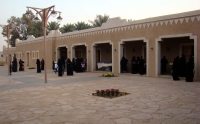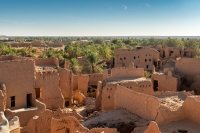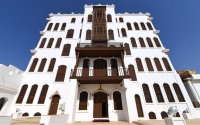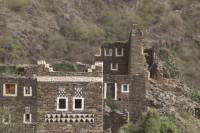
The climate plays a crucial role in the architecture of the central region, where human hamlets consist of agricultural oases located along valleys, such as Wadi Rumah in Qassim , Wadi Hanifah in Riyadh Province , and Wadi ad-Dawasir in the south. The use of mud for building and stone for foundations, mosque columns, and courtyard columns in homes is prevalent. The Najdi house is characterized by a courtyard, which is a fundamental element of the dwelling. The architectural style in the central...

The towns of Najd generally formed around and along Tuwaiq Mountain and its valleys and ravines, crafting their character from its stones and the silt of its valleys. The traditional Najdi house is characterized by its simplicity in composition and mass, with multiple elements surrounding the internal courtyard. It consists of one or two floors and typically has a single entrance that opens indirectly to the courtyard. The Najdi house includes a majlis (sitting room) located on the first floor,...

Bab Abu Khokha is one of the types of large and old doors that became famous in the Arabian Gulf countries. It is known for having a small door at the edge of the large door, used for entering and exiting without the need to open the entire door. The small door is called 'Khokha' in al-Ahsa Governorate, east of the Kingdom, and 'Farkha' in al-Qatif Governorate . The reason for its construction in this way is to preserve privacy and respect the private space of the household....

Stone Houses in Aseer are a form of construction that characterizes the urban identity of Aseer Province, southwest of the Kingdom of Saudi Arabia, and one of the traditional patterns of urban heritage in the southern provinces. They consist of forts or castles built in ancient times for fortification during maneuvers and wars. The province includes about 4,275 heritage villages, throughout which stone houses are built. Most of these architectural styles in building stone houses were formed thr...

Al-Dukka and al-Kmar are two elements of the Mashab (fireplace) or coffee room, which represent a significant part of the Najdi house in Riyadh, the capital of the Kingdom of Saudi Arabia. The construction pattern of both al-Dukka and al-Kmar is common in many provinces across the north, central, and south of the Kingdom. Al-Dukka and al-Kmar can be considered secondary elements that are associated with the construction or presence of the coffee room or Mashab. 1 2 3 Al-Dukka in the Najdi house...

The Liwan is one of the most important elements of the Najdi home in Riyadh, the capital of the Kingdom of Saudi Arabia. It is known in another context as the Salmani style. It is one of the architectural methods to combine modernity in construction and originality. In the liwan, local yet modern construction methods are used, giving buildings a diverse and contemporary heritage style. 1 2 3 Components of the liwan The liwan consists of a set of elements, including al-Asbab (or corridor or vest...

Al-Hassir is a mat woven from palm fronds in various sizes and shapes. It was historically used in the Kingdom of Saudi Arabia to cover floors and decorate homes. Nowadays, it is considered a traditional furnishing that is part of the culture and heritage of most regions of the Kingdom. Its production was prevalent in regions where palm trees were cultivated, as al-Hassir makers required palm wicker. Al-Hassir manufacturing Al-Hassir is made from a delicate palm leaf fabric, intricately woven...